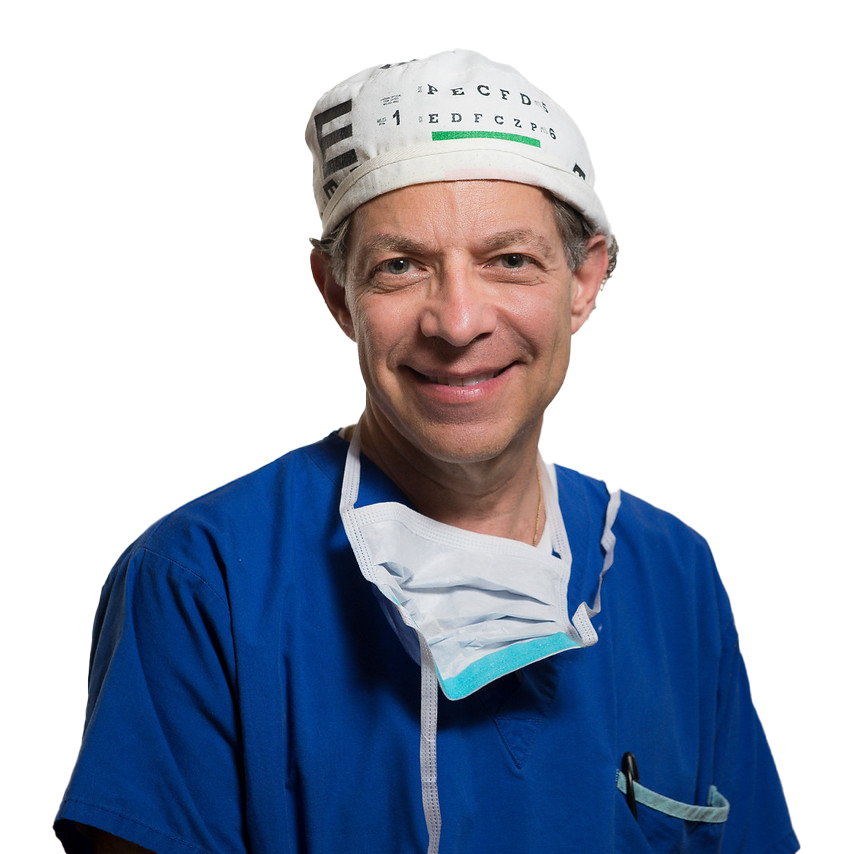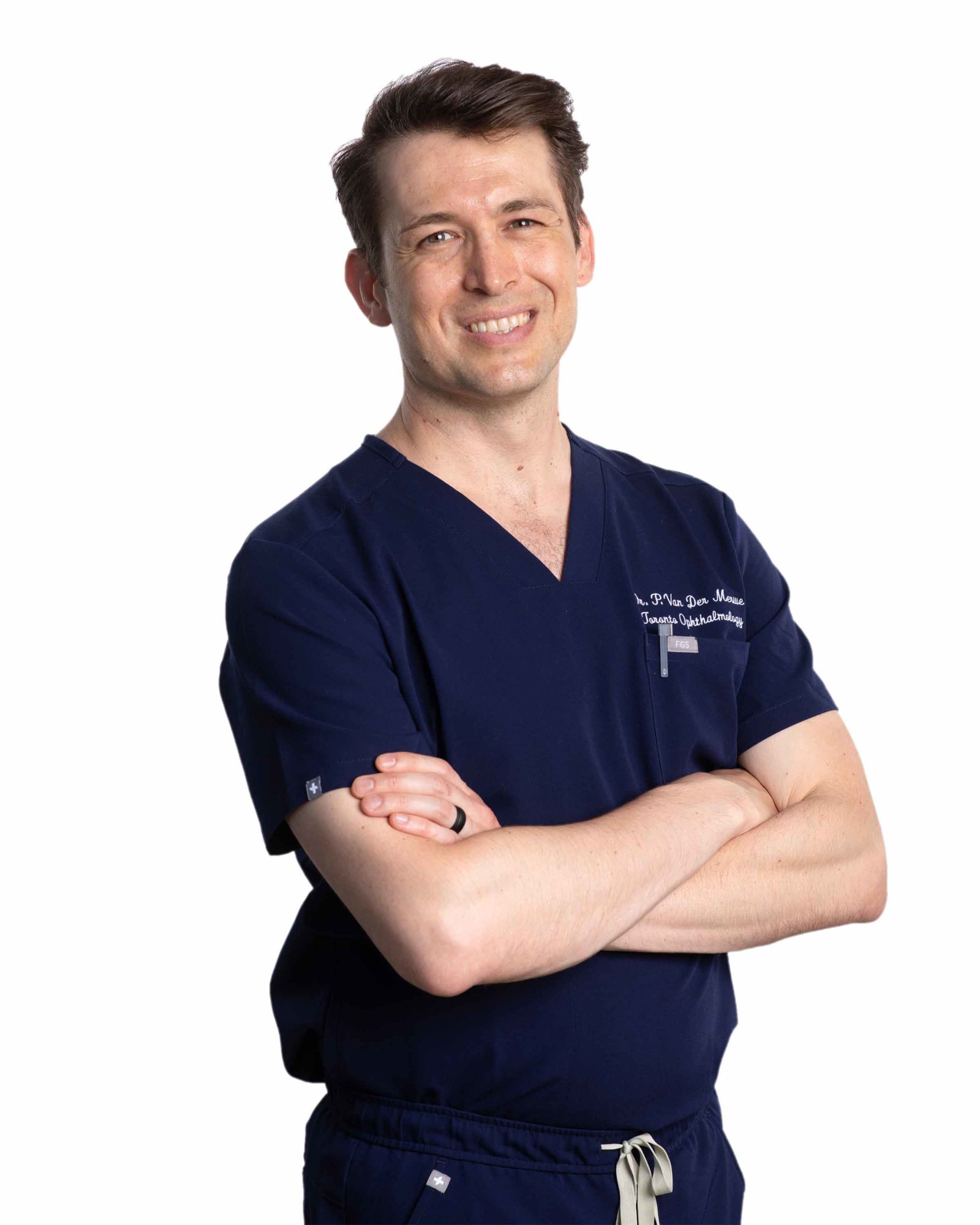Mark Firth feels like he’s been given a second chance at life, thanks to the Sprott Surgery team. (Photo: Regina Garcia)
By Elizabeth Chorney-Booth
One morning last June, Mark Firth woke up in an unfamiliar hospital bed and, to his shock, realized that he couldn’t see. As the 37-year-old from Kingston, Ont., would soon find out, a sudden and devastating accident had left him with significant trauma in both eyes, rendering him virtually blind. As a relatively young and active person with lots of friends and a job he loved with the City of Kingston, Firth had always taken his 20/20 vision for granted. Waking up without it left Firth stunned and anxious about what the rest of his life would look like.
Immediately after his accident, Firth underwent emergency surgery in Kingston to repair the damaged walls of his eyes, but both eyes were severely compromised. Each was filled with blood and had sustained damage to the lens at the front of the eye and the retina at the back. Since he couldn’t work, cook or look after himself, and had to walk with a cane, Firth had to leave his home in Kingston and move in with family in Mississauga. His left eye was more damaged than the right, but the vision in his “good eye” let in only a small amount of light.
Because his sudden disability came as such a surprise, the injuries also took an enormous personal toll. “It was having a huge effect on me mentally. Things were going through my mind that I had never thought before in my entire life,” Firth recalls. “I was always such a happy, positive and outgoing individual. I loved life and everything I did in my career, my friendships and where I lived. This just sucked the life right out of me.”
A second chance for sight
Once in Mississauga, a relative suggested Firth go see the team of surgeons in the Sprott Department of Surgery at Toronto Western Hospital, part of University Health Network (UHN). There, he was seen by Dr. Robert Devenyi, Head of the Division of Ophthalmology and Ophthalmologist-in-Chief and Co-Director of UHN’s Donald K. Johnson Eye Institute, who came up with a plan to operate on both of his eyes. In September of 2020 the team worked on Firth’s more damaged left eye, performing a retinal attachment. The eye needed to be filled with a silicone oil to replace the vitreous (the gel that fills the space in the eye between the retina and the lens) that was removed during the surgery through a process called a vitrectomy. Firth was left having to lie face down for 10 days while his retina set itself in place. While his vision in that eye remains limited, the operation was successful. His retina was reattached, and he can see more light than before.
Still, Firth’s depression and discomfort grew. Fortunately, Sprott Surgery’s team rallied around their patient and reassured him that there was hope for his right eye. He underwent two more surgeries: one in December of 2020 that marginally improved his vision with the insertion of an artificial lens and the removal of a cataract, and another in March of 2021 that changed Firth’s life forever.

Rebuilding vision
Because Firth’s right retina was torn but not completely detached, Dr. Devenyi and vitreoretinal surgery fellow Dr. Pieter Van der Merwe were able to perform a far less complicated retinal repair and vitrectomy that didn’t require him to rest face down. The day after the surgery, the clinicians were able to take off Firth’s bandages and he could see almost perfectly out of his right eye, a result that Firth describes as a “miracle.”
While the procedure used to repair the right eye is fairly common in Dr. Devenyi’s work week these days, he says that only a few years ago a case like Firth’s wouldn’t necessarily have had such a positive outcome. “The key to any operation is to be able to visualize and see what you’re doing properly. And our techniques for visualization in the operating room are so much better than they used to be,” says Dr. Devenyi, who is also the Karen and William Barnett Chair in Ophthalmology. “We have these wide-field viewing and computerized imaging systems that allow us to see at multiple levels. There’s not a week that passes when I can’t successfully repair several patients who just a few years ago would have permanently lost their sight.”
That specialized and constantly updated equipment is also handled by the surgeons’ support team, including registered nurses like Rosa Lee, who served as a scrub nurse on Firth’s final surgery. Scrub nurses are responsible for handling all sterilized equipment in the operating room, and with ophthalmology that means managing highly specialized tools.
An operating room nurse since 1989, Lee has always gravitated toward ophthalmology, and while she also serves in other settings, it’s been her specialty for the past 15 years. That expertise, which also allows her to guide less-senior nurses through these specialized procedures, makes surgeries like Firth’s go even more smoothly. “Doing ophthalmology, we have to deal with microsurgical instruments, which are very different from what’s used in something like orthopedics,” Lee says. “It’s fascinating from a nurse’s perspective to see the doctors using the technology to work inside the eye.”
Additionally, Dr. Allan Slomovic, ophthalmologist and surgeon in the Sprott Department of Surgery, Owen & Marta Boris Chair in Stem Cell Vision Research, Research Director of the Cornea/External Disease Service and Director of the Ocular Stem Cell Transplantation Program at UHN’s Donald K. Johnson Eye Institute, spearheaded numerous surgeries on Firth’s right eye. “He’s been an integral part of my rehabilitation and ability to see again,” Firth says. “Truly one of the most caring and professional doctors I’ve ever met.”
Seeing the impact
While Lee brings experience to the team, a fellow like Dr. Van der Merwe, who is here training from South Africa, represents the future of ophthalmology, learning under the guidance of more seasoned surgeons. Since Dr. Devenyi does 15 to 20 eye surgeries a week, developing an unbelievable wealth of experience, it’s important for him to pass his know-how on to younger generations of clinicians who can see the possibilities of modern ophthalmology and the way it changes the lives of patients like Firth.

“The surgeons who work here not only are extremely experienced, but they really care about their patients and the value these surgeries can add to their lives,” says Dr. Van der Merwe, who’s also part of the Donald K. Johnson Eye Institute. “As eye surgeons, we’re very aware of the impact that vision has on our patients’ lives, and we celebrate the great results with the ones that are lucky to benefit from these interventions.”
As for Firth, his life isn’t exactly back to where it was before the accident, but with the vision in his right eye fully restored, he feels like a brand-new person and is looking to get back to his job and regular routines in Kingston. He has plans to give back to the visually impaired community by volunteering with the CNIB Foundation once he’s back on his feet, as a means of thanking the Sprott Surgery team for helping to turn his life around.
“In that moment after the last surgery, when I realized I could see, I knew everything happens for a reason, and this experience is part of my story. I’ve told my doctors I’m going to make good on this. I’ve been given a second chance at life,” Firth says. “I feel like one of the luckiest people on Earth.”
